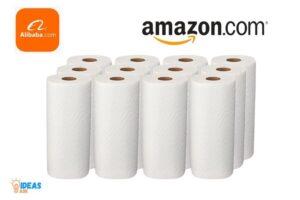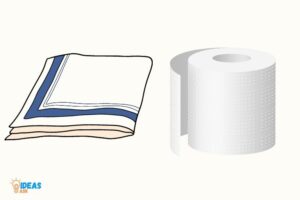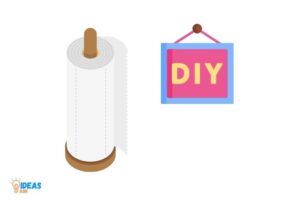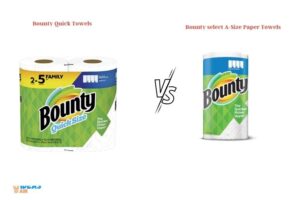Diy Reusable Paper Towels! Create & Customize
DIY reusable paper towels are an environmentally-friendly and cost-effective alternative to traditional disposable paper towels, made from fabric and designed for multiple uses before washing.
Traditional paper towels generate a significant amount of waste, contribute to deforestation, and can be expensive over time.
DIY reusable paper towels address these issues by being made from fabric, usually cotton or a blend of cotton and other materials, which can be washed and reused multiple times.
They are easy to make at home and can be customized to suit individual preferences in terms of size, design, and absorbency.
DIY reusable paper towels are an excellent way to contribute to a more sustainable lifestyle and save money at the same time.
With numerous benefits and the ability to customize them to your liking, these towels are a smart addition to any household.
They’re easy to create and maintain, making them a practical solution to traditional disposable paper towels.
Creating Diy Reusable Paper Towels: Material & Instructions
| Material | Size | Instructions | Drying and Cleaning Method |
|---|---|---|---|
| Cotton Flannel | 12″ x 12″ | 1. Cut fabric into squares.<br>2. Sew edges to prevent fraying.<br>3. Attach snaps, buttons, or Velcro to connect towels together for easy roll-up storage. | Machine wash and dry on low heat. |
| Birdseye Cotton | 11″ x 11″ | 1. Cut fabric into squares.<br>2. Sew a double fold hem around the edges.<br>3. Attach an optional loop for hanging. | Machine wash and hang dry. |
| Terry Cloth | 10″ x 10″ | 1. Cut fabric into squares.<br>2. Sew a zigzag stitch or serged edge to prevent fraying.<br>3. Fold towels and store in a basket near your workspace. | Machine wash and tumble dry on low heat. |
| Microfiber Cloth | 12″ x 16″ | 1. Cut fabric into rectangles.<br>2. Fold over edges and sew with a straight stitch.<br>3. Store towels in a designated drawer or container to keep them organized. | Machine wash and hang dry. |
| Bamboo Towels | 14″ x 14″ | 1. Purchase pre-cut bamboo towels or cut from a larger bamboo fabric roll.<br>2. Sew edges with a rolled hem or serged stitch.<br>3. Fold towels and store in a basket or on a towel bar. | Machine wash and air dry. |
Key Takeaway
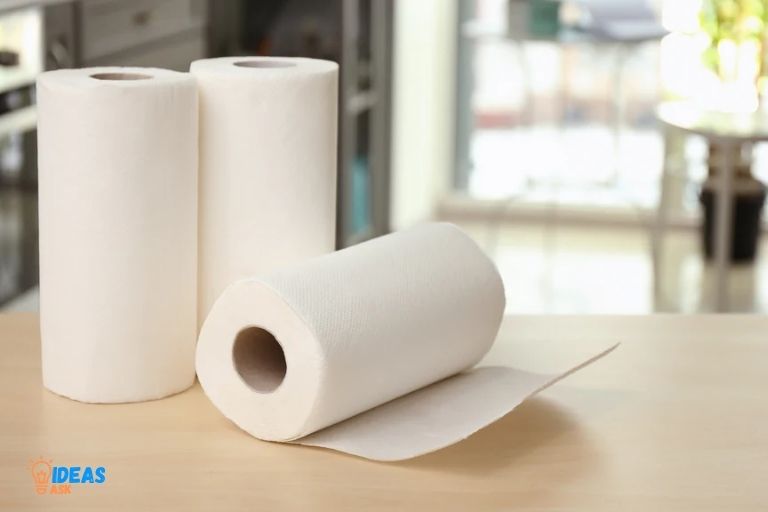
Five Facts About Diy Reusable Paper Towels
Lowering Your Carbon Footprint
Diy Reusable Paper Towels: Lowering Your Carbon Footprint
For those who desire to reduce their carbon footprint, diy reusable paper towels can be an outstanding option. While standard paper towels might seem like a small sin, it’s important to consider their impact.
They are made out of non-renewable resources and discarded after just one use, adding to our enormous landfills.
By crafting your own reusable paper towels, you can lower waste and save money. Here are several reasons why you should try it out:
Reduced Waste
The amount of waste, especially paper, that we produce is significant. Choosing to make and use diy reusable paper towels decreases the amount of waste we generate and helps to protect the planet.
The advantages include:
- Less paper waste in landfills.
- Reducing the amount of trees cut down for paper production.
- Lowering the effect of paper waste on the environment.
Reusable
Unlike traditional paper towels, diy reusable paper towels are just that, reusable. While you’ll have to wash them, this is considerably more eco-friendly than harshly discarding heaps of paper towels every day.
Here are some reasons why you should consider using reusable paper towels:
- They are eco-friendly.
- They are more cost-effective, saving you money.
- By reusing these towels, you help to reduce waste.
Here are some factors to think of when it comes to utilizing reusable paper towels:
- Reusable paper towels are usually made from cotton material or other recycled fabrics.
- They are washable, so after they get dirty, you just toss them in the washing machine.
One-Time Investment
Making diy reusable paper towels requires a one-time investment but saves money in the long run.
You won’t have to purchase paper towels repeatedly, and you can avoid chemical-laden ones altogether. Despite the initial investment, reusable paper towels make more sense in the long run.
Here are some reasons why:
- They are a one-time investment.
- By making them yourself, you save money.
- Reusable paper towels have a longer life span.
Diy reusable paper towels are an excellent way to reduce your carbon footprint and be more eco-friendly.
They are more cost-effective, have a life span longer than traditional paper towels, and made from eco-friendly materials. These towels are an excellent alternative for those who want to be environmentally conscious.
So, try it out and reduce your environmental impact today!
Cost Savings
Diy Reusable Paper Towels: Cost Savings
Are you tired of constantly throwing away paper towels after using them just once? Not only is it wasteful, but it can also become costly in the long run.
That’s where reusable paper towels come in! Creating your own diy reusable paper towels may seem like a daunting task, but the cost savings and environmental impact make it all worth it.
Comparing The Costs
When comparing the cost of traditional paper towels to reusable ones, it’s clear that the latter is the more cost-effective option.
Traditional paper towels can cost anywhere from $0. 01 to $0. 03 per sheet, while diy reusable paper towels can cost as little as $0.007 per sheet.
Saving Money Over Time
By using diy reusable paper towels, you not only save money on purchasing paper towels multiple times a week, but you also save money on trash bags as there are fewer of them to be thrown away.
Additionally, because diy reusable paper towels are made from fabric scraps, old t-shirts, or towels, you can save money on materials by repurposing what you already have at home.
Diy Projects As A Rewarding Activity
Making diy reusable paper towels can be an enjoyable and fulfilling activity. Not only is it an excellent way to save money and reduce waste, but it also allows you to express your creativity and resourcefulness.
You can customize the reusable paper towels to your liking, whether that means making them a specific size or pattern.
Plus, it’s a great opportunity to involve family members or friends in a fun and eco-friendly project.Diy reusable paper towels can be a simple yet effective way to save money while also reducing waste.
By comparing the costs, emphasizing the long-term savings, and highlighting the rewarding nature of the project, it’s clear that creating your own reusable paper towels is the way to go!
Cotton And Terry Cloth
Diy Reusable Paper Towels: Cotton And Terry Cloth
When it comes to using paper towels, the cost of constantly replenishing them can quickly add up. This is where reusable paper towels come in; not only are they eco-friendly and more economical, but they also keep waste out of landfills.
If you’re looking for the perfect material for your reusable paper towels, you can choose between cotton and terry cloth.
Pros And Cons
Cotton:
Pros:
- Lightweight for easy wash and care
- Soft and gentle on skin and surfaces
- Durable and long-lasting
Cons:
- Can shrink after washing
- May not absorb as much liquid as terry cloth
- May leave lint behind on surfaces
Terry cloth:
Pros:
- More absorbent than cotton
- Ideal for heavy-duty cleaning
- Great for cleaning spills and messes
Cons:
- Can be heavier and bulkier than cotton
- Can be harder to wash and care for
- May not be as soft as cotton
Best Uses
Cotton:
- Great for drying hands
- Perfect for everyday light cleaning
- Ideal for dusting furniture and surfaces
Terry cloth:
- Ideal for cleaning kitchen countertops and appliances
- Great for wiping up spills and messes
- Perfect for cleaning bathrooms and showers
Choosing between cotton and terry cloth for your reusable paper towels will depend on your personal preference and usage needs.
Both materials have their pros and cons, but they are undoubtedly more eco-friendly alternatives to traditional paper towels.
So, try making your diy reusable paper towels using either material and reap the benefits of waste-reduction and cost-effectiveness!
Hemp And Bamboo
Diy Reusable Paper Towels: Hemp And Bamboo
Paper towels are a staple in every household as they are convenient, but they are also a significant contributor to environmental waste.
One way to reduce this waste is to switch to reusable paper towels. These towels are eco-friendly and can be made from various materials such as hemp and bamboo.
We focus on the benefits and drawbacks of using hemp and bamboo for reusable paper towels and the best uses for them.
Pros And Cons
Hemp:
- High absorbency rate
- Durable and tear-resistant
- Naturally antibacterial and antimicrobial
- Grows quickly without pesticides and herbicides
- More expensive compared to other materials
- Can be rough initially, but becomes softer with use
Bamboo:
- Highly absorbent
- Soft to the touch
- Naturally antibacterial and antimicrobial
- Increases oxygen in the air and helps reduce carbon dioxide
- Grows quickly without pesticides and herbicides
- Not as durable as hemp, may need to be replaced more frequently
Best Uses
Hemp:
- Cleaning up spills and messes
- Drying dishes and surfaces
- Wiping hands and faces
- Cleaning surfaces in the kitchen and bathroom
Bamboo:
- Wiping delicate surfaces such as glassware and screens
- Cleaning and dusting furniture
- Drying fruits and vegetables
- Makeup removal and general personal hygiene
Using reusable paper towels made from hemp and bamboo can significantly reduce paper waste and environmental pollution.
Both materials have their advantages and disadvantages, but choosing one over the other ultimately depends on personal preferences and intended use.
By making the switch to reusable paper towels, you are not only contributing to a sustainable future but also saving money in the long run.
Choosing The Right Fabric
Diy Reusable Paper Towels: Choosing The Right Fabric
When it comes to reducing waste and adopting a more eco-friendly lifestyle, diy projects can be a great place to start.
Reusable paper towels are one such project that can make a significant impact on your daily life. However, choosing the right fabric is crucial to ensure durability and absorbency.
Durability And Absorption
When choosing the fabric for your reusable paper towels, consider its durability and absorbency.
Here are some options to consider:
- Cotton: Cotton is the most popular fabric choice for reusable paper towels due to its durability and high absorbency.
- Bamboo: Bamboo fabric is another option that has become increasingly popular in recent years. It’s sustainable, hypoallergenic, and has natural antibacterial properties, making it an excellent choice for reusable paper towels.
- Linen: Linen is a highly absorbent, durable, and sustainable fabric option that’s easy to care for and lasts for a long time.
Colors And Patterns
Choosing the right colors and patterns for your reusable paper towels can enhance their appearance and make them more enjoyable to use.
Here are some factors to consider when selecting colors and patterns:
- Consider your decor: Choose colors and patterns that complement your kitchen decor and style.
- Bright colors: Bright colors like green, red, and yellow can help bring a pop of color to your kitchen, making it more inviting to spend time in.
- Dark colors: Darker colors like black and navy can be less likely to show stains, making them practical choices for busy households.
- Patterns: Choose patterns that bring joy and a sense of fun to your kitchen. Florals, stripes, and polka dots are popular options.
Reusable paper towels are an excellent way to reduce waste and live a more eco-friendly lifestyle. By choosing the right fabric, colors, and patterns, you can create a functional and beautiful addition to your kitchen while being kind to the environment.
Preparing Your Fabric
Diy Reusable Paper Towels – Preparing Your Fabric
Before you can start creating your reusable paper towels, you need to prepare your fabric. Follow these simple steps to ensure your fabric is ready for use.
Pre-Washing And Drying
- Wash your fabric in hot water, to remove any sizing or dirt.
- Dry your washed fabric in the dryer on high heat.
By doing so, the fabric fibers will shrink, and you won’t have any surprises after creating your reusable paper towels.
Ironing And Cutting
- Once the fabric is dry, iron it to remove any wrinkles or creases.
- Then cut the fabric to the desired size and shape for your paper towels.
Ironing your fabric will make it easier to cut precisely, ensuring that each paper towel has a uniform size. Remember that a rotary cutter with a cutting mat will produce cleaner edges than scissors.
Now that your fabric is ready, you’re almost ready to start creating your diy reusable paper towels! Continue reading to find out more about the process.
Remember, following the proper preparation of your fabric ensures that your reusable paper towels will last a long time, and you’ll get the most out of your materials.
Sewing Your Diy Reusable Paper Towels
If you’ve made it this far, then you’re ready to sew your diy reusable paper towels. Congrats! In this section, we’ll guide you through the necessary steps for sewing your towels.
There are two methods to choose from: machine sewing or hand sewing. You’ll also learn how to add snaps or velcro to your towels to secure them properly.
Step-By-Step Guide
Here are the step-by-step instructions for sewing your diy reusable paper towels:
- Firstly, decide on the size and shape of your towels. Cut your fabric into rectangular shapes. Ensure that you cut the same number of top and bottom pieces.
- Next, place the right sides of the top and bottom pieces together. Attach these pieces by sewing along the sides. Make sure to leave one side open for turning.
- Turn the fabric right side out through the open side.
- Sew along the sides again. This creates a finished edge and ensures the towel is durable.
- Repeat this process until you have the desired number of paper towels.
Machine Or Hand Sewing
Both machine and hand sewing are suitable for making reusable paper towels. Which one you choose depends on your preference.
If you prefer a quick, precise, and efficient method, then machine sewing is ideal. On the other hand, if you enjoy a traditional and personal touch, then hand sewing is for you.
Adding Snaps Or Velcro
Adding snaps or velcro to your reusable paper towels will prevent them from unravelling.
Here are the steps to take:
- Cut two strips of 1-inch velcro or snaps.
- Sew one strip on the middle of the bottom side, and the other at the opposite end of the top side. Make sure to sew them on the finished side of the towel.
- Align the snaps or velcro pieces.
- Fold your towel in half with the right sides together.
- Sew the two edges of the towel together, leaving the snaps or velcro on the top side of your towel.
Now that you’ve completed your diy reusable paper towels, they are ready to use instead of traditional paper towels.
Not only are they eco-friendly, but they can also save you money in the long run. We hope you enjoyed this tutorial, and happy sewing!
Washing And Drying
Diy Reusable Paper Towels – Washing And Drying
Now that you have created your diy reusable paper towels, you must know how to take care of them so they last longer. Caring for your towels is essential to keep them clean and hygienic.
Here are some tips to help you care for your reusable paper towels.
Caring For Your Towels
- Before using your towels for the first time, wash them to remove any dirt or residue left over from the manufacturing process.
- After each use, rinse the towels with cold water to remove any food particles and stains.
- Do not use fabric softener or bleach, as this could damage the fabric.
- When it’s time to wash your towels, separate them from other laundry.
- Wash your towels in cold or warm water, with a mild detergent.
- You can either air-dry them or tumble dry them on a low setting.
Stain Removal Tips
It’s common for reusable paper towels to get stained.
Here are some tips to remove the stains easily:
- Wet the stain with cold water as soon as possible.
- Apply a stain remover or pre-treatment solution to the stained area.
- Let the stain remover work for at least 5 minutes before washing the towels.
- Wash the towels as per the instructions given above.
- Check the stain after washing. If it is still there, repeat the process before drying the towels.
By following these tips, you can ensure that your diy reusable paper towels last longer and stay clean and fresh.
Keep your towels in a designated location so you don’t mix them up with your other laundry, and always wash them promptly after use. You can also experiment with different fabrics to see which ones work best for you. Happy cleaning!
FAQ Of Diy Reusable Paper Towels
How Do You Wash Reusable Paper Towels?
Reusable paper towels can be washed in the washing machine with your regular laundry. Use cold water and mild detergent to avoid shrinkage.
How Many Times Can You Reuse A Paper Towel?
Reusable paper towels can be used up to 100-200 times depending on the quality of the material used.
What Are The Best Fabrics For Diy Reusable Paper Towels?
Cotton, linen, bamboo, and hemp are the best fabrics for making reusable paper towels as they are highly absorbent and durable.
How Do Reusable Paper Towels Help The Environment?
Reusable paper towels help reduce waste and environmental pollution caused by disposable paper towels. They are eco-friendly and sustainable.
Conclusion
To sum up, switching to reusable paper towels is one of the easiest steps you can take towards a sustainable lifestyle. By making your own, you can not only save money but also reduce your carbon footprint and protect the environment.
The materials required are cheap and easily available, and the process is simple and fun. Reusable paper towels offer the same functionality as conventional ones, but with the added benefit of being washable and long-lasting. By using them, you can significantly reduce the amount of waste generated in your household while also inspiring others to make similar changes.
So why not give them a try? By taking small steps like this, we can collectively make a big impact and build a cleaner and greener future for ourselves and generations to come.


